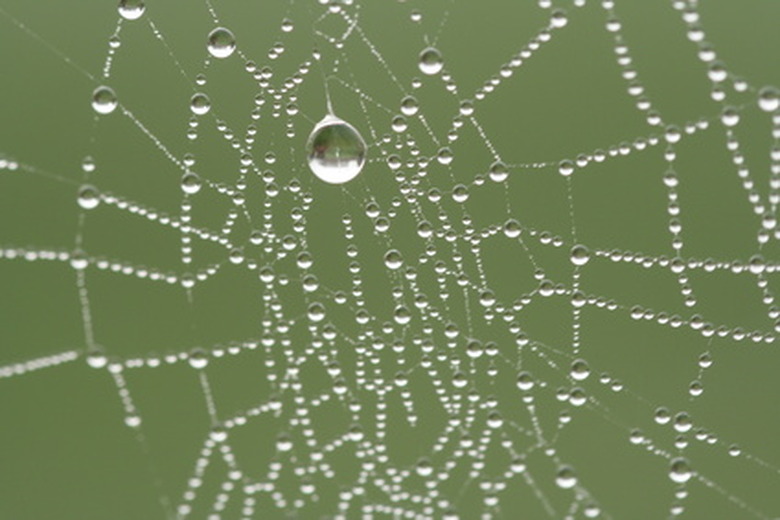How To Calculate Grains Of Moisture
Important to engineers and meteorologists alike, the field of psychrometrics explores the thermodynamic properties of gas-liquid mixtures, including air and water vapor. The particular concentration of water vapor in air is a psychrometric property known as "absolute humidity". In the U.S. measurement system, absolute humidity is typically measured in "grains of moisture" per cubic foot of air. To calculate this figure, you need four pieces of data: atmospheric pressure, air temperature, dry bulb temperature, and wet bulb temperature.
Collecting Data
Step 1
Turn on your digital barometer and record the atmospheric pressure, in inches of mercury (inHg). If the barometer measures the pressure in "pounds-per-square-inch (psi)," multiply the pressure by 2.036 to convert its units to inHg. If the barometer measures in "Torr" or "mmHg," multiply by 0.0393 to convert to inHg. If the barometer measures in "atm," multiply by 29.92 to convert to inHg.
Step 2
Turn on your digital psychrometer.
Step 3
Read the psychrometer to find the "dry bulb" temperature of the air, in degrees Fahrenheit. Note: depending on the model, there may not be a distinction between dry bulb temperature and air temperature. However, these two terms refer to the same property, making them interchangeable.
Step 4
Read the "wet bulb" temperature of the air from the psychrometer, in degrees Fahrenheit.
Calculating Absolute Humidity, If The Wet Bulb Temperature Is At Or Below 32°F
Step 1
Subtract the wet bulb temperature (from section 1, step 4) from the dry bulb temperature (from section 1, step 3).
Step 2
Multiply the result from section 2, step 1 by the atmospheric pressure (from section 1, step 1).
Step 3
Multiply the wet bulb temperature (from section 1, step 4) by 2.336 x 10^-7.
Step 4
Add 3.595 x 10^-4 to the result from section 2, step 3.
Step 5
Multiply the result from section 2, step 1 by section 2, step 4.
Step 6
Add 459.4 to the wet bulb temperature (from section 1, step 4).
Step 7
Divide -4869.38 by the result from section 2, step 6.
Step 8
Add 10.0343 to the result from section 2, step 7.
Step 9
Take 10 to the power of the result from section 2, step 8. For example, if the result from the previous step was "-2046.3", you would enter "10^(-2046.3)" on your graphing calculator.
Step 10
Take the result from section 2, step 6 (i.e. wet bulb temperature plus 459.4) to the -0.32286 power.
Step 11
Multiply the result from section 2, step 10 by the result from section 2, step 9.
Step 12
Subtract the result from section 2, step 5 from the result of section 2, step 11.
Step 13
Add 459.4 to the dry bulb temperature (from section 1, step 3).
Step 14
Divide the result from section 2, step 12 by the result from section 2, step 13.
Step 15
Multiply the result from section 2, step 14 by 0.82455. The figure you calculate will be the absolute humidity for the air, measured in pounds per cubic foot.
Step 16
Multiply the result from section 2, step 15 by 7000 to convert its units to "grains of moisture (per cubic foot)."
Calculating Absolute Humidity, If The Wet Bulb Temperature Is Above 32°F
Step 1
Subtract the wet bulb temperature (from section 1, step 4) from the dry bulb temperature (from section 1, step 3).
Step 2
Multiply the result from section 3, step 1 by the atmospheric pressure (from section 1, step 1).
Step 3
Multiply the wet bulb temperature (from section 1, step 4) by 2.336 x 10^-7.
Step 4
Add 3.595 x 10^-4 to the result from section 3, step 3.
Step 5
Multiply the result from section 3, step 1 by the result from section 3, step 4.
Step 6
Add 459.4 to the wet bulb temperature (from section 1, step 4).
Step 7
Divide -5287.32 by the result from section 3, step 6.
Step 8
Add 23.2801 to the result from section 3, step 7.
Step 9
Take 10 to the power of the result from section 3, step 8. For example, if the result from the previous step was "-3026.9", you would enter "10^(-3026.9)" on your graphing calculator.
Step 10
Take the result from section 3, step 6 (i.e. wet bulb temperature plus 459.4) to the -4.9283 power.
Step 11
Multiply the result from section 3, step 10 by the result from section 3, step 9.
Step 12
Subtract the result from section 3, step 5 from the result of section 3, step 11.
Step 13
Add 459.4 to the dry bulb temperature (from section 1, step 3).
Step 14
Divide the result from section 3, step 12 by the result from section 3, step 13.
Step 15
Multiply the result from section 3, step 14 by 0.82455. The figure you calculate will be the absolute humidity for the air, measured in pounds per cubic foot.
Step 16
Multiply the result from section 3, step 15 by 7000 to convert its units to "grains of moisture (per cubic foot)."
Things Needed
- Digital barometer
- Digital psychrometer with dry bulb and wet bulb thermometers
- Graphing calculator
Cite This Article
MLA
Pasquesi, Andy. "How To Calculate Grains Of Moisture" sciencing.com, https://www.sciencing.com/calculate-grains-moisture-6085656/. 24 April 2017.
APA
Pasquesi, Andy. (2017, April 24). How To Calculate Grains Of Moisture. sciencing.com. Retrieved from https://www.sciencing.com/calculate-grains-moisture-6085656/
Chicago
Pasquesi, Andy. How To Calculate Grains Of Moisture last modified March 24, 2022. https://www.sciencing.com/calculate-grains-moisture-6085656/
